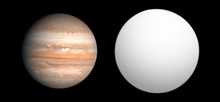The Hungarian Automated Telescope Network (HATNet) project is a network of six small fully automated "HAT" telescopes. The scientific goal of the project is to detect and characterize extrasolar planets using the transit method. This network is used also to find and follow bright variable stars. The network is maintained by the Center for Astrophysics | Harvard & Smithsonian.

XO-3b is an exoplanet with about 11.79 times the mass of Jupiter, and it orbits its parent star in about 3.2 days. The radius of this object is 1.217 times that of Jupiter. Astronomers announced their discovery on May 30, 2007, at the American Astronomical Society in Honolulu, Hawaii. Its discovery is attributed to the combined effort of amateur and professional astronomers working together on the XO Project using a telescope located on the Haleakala summit in Hawaii.
WASP-2 is a binary star system in the Delphinus constellation located about 500 light-years away. The primary is magnitude 12 orange dwarf star, orbited by red dwarf star on wide orbit. The star system shows an infrared excess noise of unknown origin.

HAT-P-4b is a confirmed extrasolar planet orbiting the star HAT-P-4 over 1000 light years away in Boötes constellation. It was discovered by transit on October 2, 2007, which looks for slight dimming of stars caused by planets that passed in front of them. It is the fourth planet discovered by the HATNet Project. It is also called BD+36 2593b, TYC 2569-01599-1b, 2MASS J15195792+3613467b, SAO 64638b.
HAT-P-5 is a 12th magnitude star in the constellation Lyra, approximately 1,000 light years away from Earth. It is a spectral type G star, about 1.16 solar masses and radii greater than the Sun, and only 200 kelvins hotter. It is estimated to be 2.6 billion years old.

HAT-P-5b is a transiting extrasolar planet located approximately 1000 light-years away in the constellation of Lyra, orbiting the star HAT-P-5. It is a hot Jupiter with a mass 6% greater than Jupiter and a radius 26% greater than Jupiter, corresponding to a density of 0.66 g/cm3, which is less than water. This planet was found by Bakos et al. on October 9, 2007.

WASP-4b is an extrasolar planet approximately 891 light-years away in the constellation of Phoenix.
HAT-P-4 is a wide binary star consisting of a pair of G-type main-sequence stars in the constellation of Boötes. It is also designated BD+36°2593.
HAT-P-12 is a magnitude 13 low-metallicity K dwarf star approximately 463 light years away in the constellation Canes Venatici, which hosts one known exoplanet.

WASP-43b, formally named Astrolábos, is a transiting planet in orbit around the young, active, and low-mass star WASP-43 in the constellation Sextans. The planet is a hot Jupiter with a mass twice that of Jupiter, but with a roughly equal radius. WASP-43b was flagged as a candidate by the SuperWASP program, before they conducted follow-ups using instruments at La Silla Observatory in Chile, which confirmed its existence and provided orbital and physical characteristics. The planet's discovery was published on April 14, 2011.
WASP-104b is a hot Jupiter exoplanet that orbits the star WASP-104. It is considered to be one of the darkest exoplanets discovered. WASP-104b was discovered in 2014; according to a 2018 study at Keele University, the planet's dense atmosphere of potassium and sodium absorbs more than 97% of light it receives.
WASP-37 is a yellow main sequence star in the constellation of Virgo.
WASP-36 is a yellow main sequence star in the Hydra constellation.
WASP-63, also known as CD-38 2551, is a single star with an exoplanetary companion in the southern constellation of Columba. It is too faint to be visible with the naked eye, having an apparent visual magnitude of 11.1. The distance to this system is approximately 942 light-years based on parallax measurements, but it is drifting closer with a radial velocity of −24 km/s.
WASP-52 is a K-type main-sequence star about 570 light-years away. It is older than the Sun at 10.7+1.9
−4.5 billion years, but it has a similar fraction of heavy elements. The star has prominent starspot activity, with 3% to 14% of the stellar surface covered by areas 575±150 K cooler than the rest of the photosphere.
WASP-75 is a F-type main-sequence star about 980 light-years away. The star is much younger than the Sun at approximately 2.9±0.2 billion years. WASP-75 is similar to the Sun in its concentration of heavy elements.
WASP-80 is a K-type main-sequence star about 162 light-years away. The star's age is much younger than the Sun's at 1.352±0.222 billion years. WASP-80 is similar to the Sun in concentration of heavy elements, although this measurement is highly uncertain.
Qatar-4 is a faint K-dwarf star that hosts a planet in the constellation Andromeda. With an apparent magnitude of 13.60, it is impossible to detect with the naked eye, but can be detected with a powerful telescope. Qatar-4 is currently located 1,083 light years away based on parallax.





